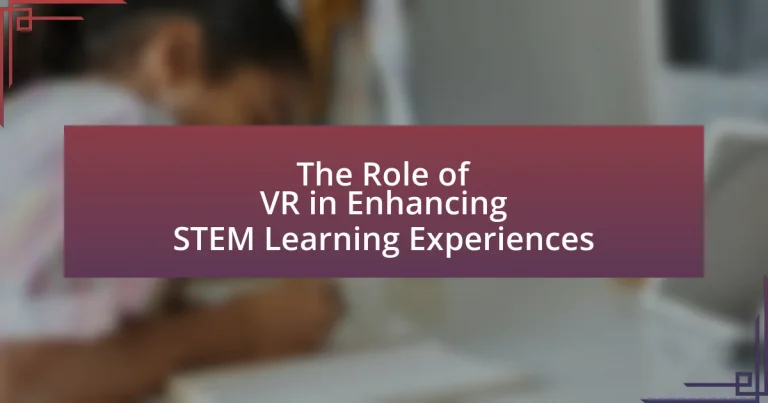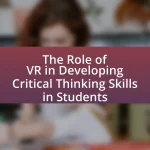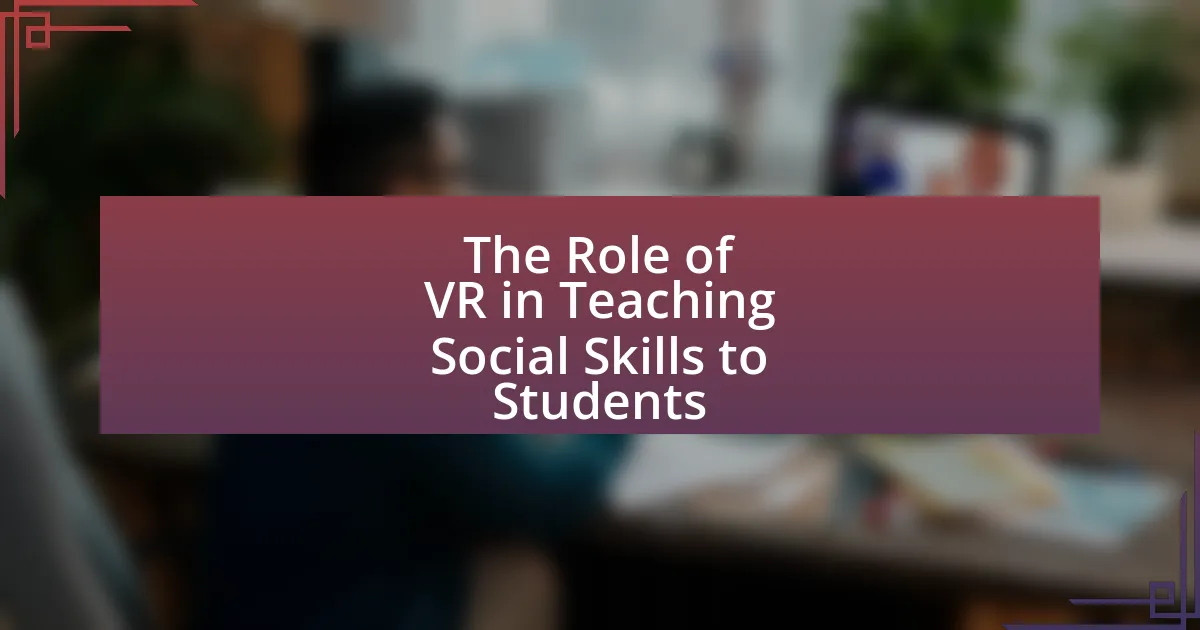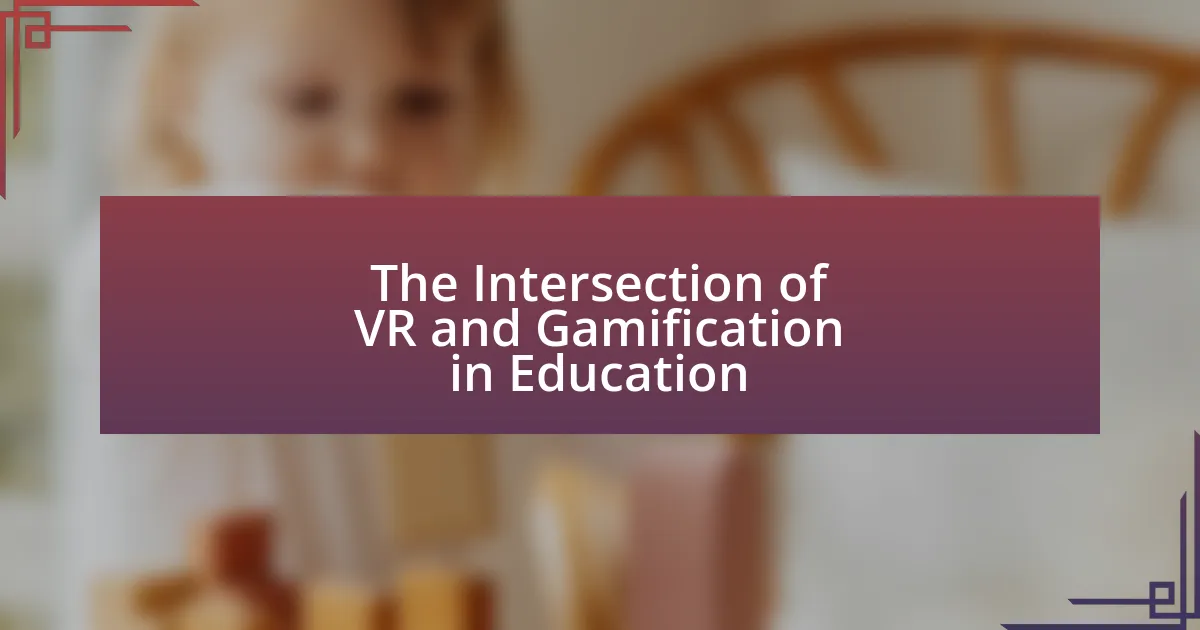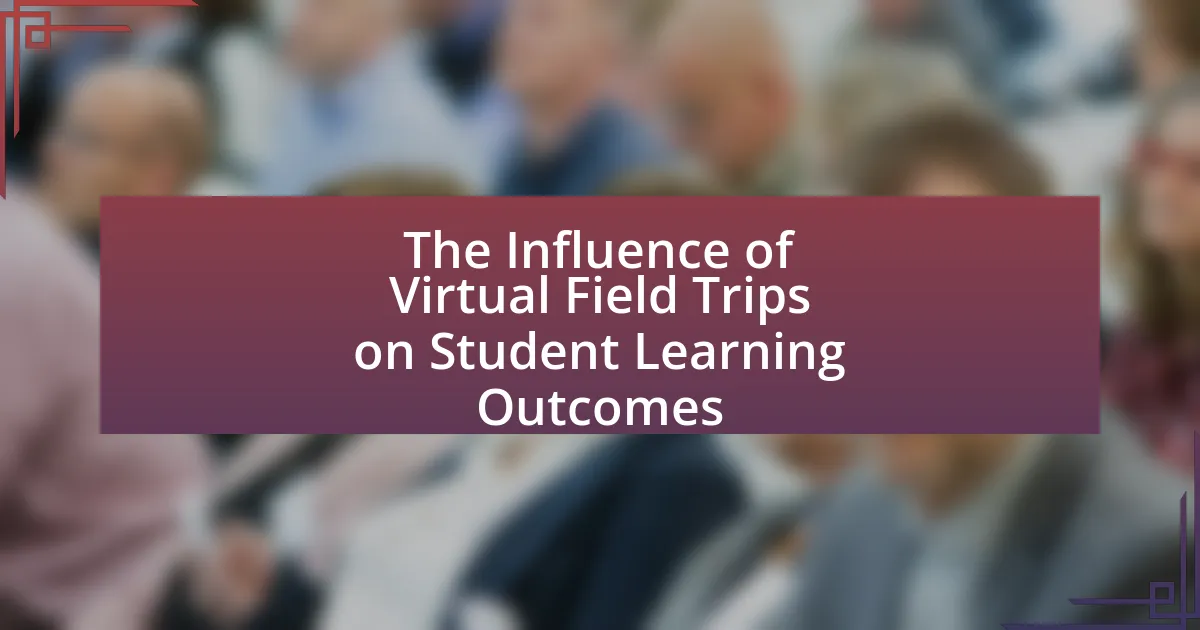Virtual Reality (VR) significantly enhances STEM learning experiences by providing immersive and interactive environments that improve student engagement and retention. Research indicates that VR facilitates experiential learning, allowing students to conduct virtual experiments and visualize complex scientific concepts, leading to better comprehension and problem-solving skills. The article explores the integration of VR in STEM education, its key features, specific applications in subjects like biology, chemistry, physics, and engineering, as well as the challenges and limitations of implementing VR technology in classrooms. Additionally, it discusses best practices for educators to effectively utilize VR tools to maximize learning outcomes in STEM fields.

What is the Role of VR in Enhancing STEM Learning Experiences?
Virtual Reality (VR) plays a significant role in enhancing STEM learning experiences by providing immersive, interactive environments that facilitate deeper understanding of complex concepts. Research indicates that VR can improve engagement and retention rates among students; for instance, a study published in the journal “Computers & Education” found that students using VR for learning exhibited a 76% increase in knowledge retention compared to traditional methods. Additionally, VR allows for experiential learning, enabling students to conduct virtual experiments and simulations that would be impractical or impossible in real life, thereby fostering critical thinking and problem-solving skills.
How does VR technology integrate into STEM education?
VR technology integrates into STEM education by providing immersive, interactive experiences that enhance understanding of complex concepts. For instance, virtual reality allows students to visualize and manipulate 3D models of scientific phenomena, such as molecular structures or astronomical bodies, which can lead to improved retention and comprehension. Research conducted by the University of Maryland found that students using VR for learning science scored 20% higher on assessments compared to traditional methods, demonstrating the effectiveness of VR in educational settings. This integration not only fosters engagement but also facilitates experiential learning, making abstract ideas more tangible and accessible for students.
What are the key features of VR that support STEM learning?
Key features of VR that support STEM learning include immersive simulations, interactive environments, and experiential learning opportunities. Immersive simulations allow students to engage with complex scientific concepts in a virtual space, enhancing understanding through visualization and manipulation of 3D models. Interactive environments enable learners to experiment and explore scenarios that would be difficult or impossible in the real world, fostering critical thinking and problem-solving skills. Experiential learning opportunities in VR provide hands-on experiences, which have been shown to improve retention and application of knowledge, as evidenced by studies indicating that students who learn through VR perform better in assessments compared to traditional methods.
How does VR facilitate experiential learning in STEM subjects?
VR facilitates experiential learning in STEM subjects by providing immersive, interactive environments that simulate real-world scenarios. This technology allows students to engage in hands-on activities, such as conducting virtual experiments or exploring complex systems, which enhances their understanding of abstract concepts. Research indicates that VR can improve retention rates and increase student motivation; for instance, a study published in the Journal of Educational Technology & Society found that students using VR for science education scored significantly higher on assessments compared to those using traditional methods. This evidence supports the effectiveness of VR in creating engaging and effective learning experiences in STEM education.
Why is VR important for STEM education?
VR is important for STEM education because it provides immersive, interactive experiences that enhance understanding of complex concepts. By simulating real-world scenarios, VR allows students to visualize and manipulate scientific phenomena, making abstract ideas more tangible. Research from the University of Maryland found that students using VR for learning scored 30% higher on assessments compared to traditional methods, demonstrating its effectiveness in improving educational outcomes. Additionally, VR fosters engagement and motivation, which are critical for learning in STEM fields.
What challenges in traditional STEM education does VR address?
Virtual Reality (VR) addresses several challenges in traditional STEM education, including limited engagement, lack of hands-on experience, and difficulties in visualizing complex concepts. Traditional STEM education often struggles to maintain student interest, as passive learning methods can lead to disengagement; VR immerses students in interactive environments that enhance motivation and participation. Furthermore, VR provides simulated hands-on experiences that are often impractical in real-world settings, allowing students to experiment and learn from mistakes without real-world consequences. Additionally, VR helps students visualize abstract concepts, such as molecular structures or astronomical phenomena, making them more accessible and understandable. Studies have shown that VR can significantly improve learning outcomes in STEM subjects by fostering deeper understanding and retention of knowledge.
How does VR improve student engagement and motivation in STEM fields?
VR improves student engagement and motivation in STEM fields by providing immersive, interactive experiences that enhance learning. This technology allows students to visualize complex concepts, conduct virtual experiments, and explore environments that would be impossible or impractical in a traditional classroom setting. Research indicates that students using VR in STEM education show increased interest and retention of information, as evidenced by a study published in the Journal of Educational Technology & Society, which found that 85% of students reported higher motivation levels when learning through VR compared to conventional methods. Additionally, VR fosters collaboration among students, as they can work together in virtual spaces, further enhancing their engagement and motivation.
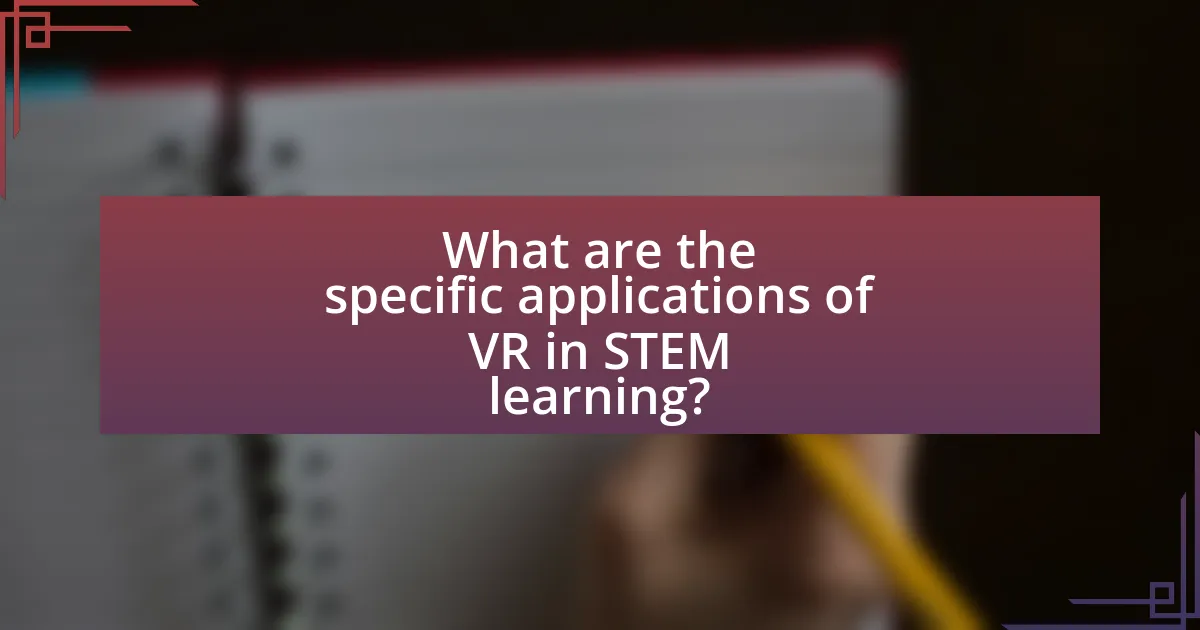
What are the specific applications of VR in STEM learning?
Virtual Reality (VR) is applied in STEM learning through immersive simulations, interactive environments, and virtual labs. These applications allow students to engage in complex scientific experiments, visualize abstract concepts, and explore environments that are otherwise inaccessible. For instance, VR enables students to conduct chemistry experiments in a safe virtual lab, where they can manipulate substances without risk. Additionally, VR can simulate astronomical phenomena, allowing learners to explore the universe and understand celestial mechanics firsthand. Research has shown that these immersive experiences can enhance understanding and retention of STEM concepts, as evidenced by a study published in the Journal of Educational Technology & Society, which found that students using VR for science education demonstrated improved learning outcomes compared to traditional methods.
How is VR used in teaching science concepts?
VR is used in teaching science concepts by providing immersive simulations that allow students to explore complex scientific phenomena in a virtual environment. For example, VR can simulate the molecular structure of compounds, enabling students to visualize and interact with atoms and molecules in three dimensions, which enhances their understanding of chemistry. Research conducted by Mikropoulos and Natsis (2011) in the “International Journal of Science Education” demonstrates that students who engaged with VR simulations showed improved comprehension of scientific concepts compared to traditional teaching methods. This evidence supports the effectiveness of VR in making abstract science concepts more tangible and accessible for learners.
What are examples of VR simulations in biology and chemistry?
Examples of VR simulations in biology include virtual dissections, such as those offered by platforms like Labster, which allow students to explore anatomical structures in a 3D environment. In chemistry, VR simulations like ChemCollective enable users to conduct virtual experiments, manipulating chemical reactions and observing outcomes without physical materials. These simulations enhance understanding by providing immersive, interactive experiences that reinforce theoretical concepts through practical application.
How does VR enhance understanding of physics principles?
VR enhances understanding of physics principles by providing immersive, interactive simulations that allow learners to visualize and manipulate complex concepts in real-time. This technology enables students to experience phenomena such as gravity, motion, and electromagnetism firsthand, which can lead to deeper comprehension. Research conducted by the University of Maryland found that students using VR for physics education scored significantly higher on assessments compared to those using traditional methods, demonstrating the effectiveness of VR in improving learning outcomes.
What role does VR play in engineering education?
VR plays a significant role in engineering education by providing immersive, interactive environments that enhance learning and understanding of complex concepts. This technology allows students to visualize and manipulate 3D models, conduct virtual experiments, and engage in simulations that replicate real-world engineering challenges. Research indicates that VR can improve spatial awareness and problem-solving skills, which are crucial in engineering disciplines. For instance, a study published in the Journal of Engineering Education found that students using VR for design projects demonstrated a 30% increase in retention of spatial concepts compared to traditional methods. This evidence underscores the effectiveness of VR in fostering deeper comprehension and practical skills in engineering education.
How can VR assist in design and prototyping processes?
VR can assist in design and prototyping processes by providing immersive environments that allow designers to visualize and interact with their concepts in real-time. This technology enables rapid iteration and modification of designs, facilitating immediate feedback and collaboration among team members. For instance, a study by the University of Illinois found that using VR in design processes can reduce prototyping time by up to 30%, as it allows for quicker identification of design flaws and enhances spatial understanding.
What are the benefits of using VR for engineering simulations?
The benefits of using VR for engineering simulations include enhanced visualization, improved understanding of complex concepts, and increased engagement in learning. VR allows engineers to visualize designs and processes in a three-dimensional space, making it easier to comprehend intricate details and relationships. Studies have shown that immersive environments can lead to better retention of information; for instance, a study published in the Journal of Engineering Education found that students using VR for simulations scored 30% higher on assessments compared to traditional methods. Additionally, VR fosters a more interactive learning experience, which can lead to greater motivation and interest in STEM fields.
How does VR contribute to mathematics learning?
VR enhances mathematics learning by providing immersive, interactive environments that facilitate conceptual understanding and problem-solving skills. Research indicates that VR can improve spatial reasoning, a critical component of mathematics, by allowing students to visualize and manipulate mathematical concepts in three dimensions. For instance, a study published in the journal “Computers & Education” by Mikropoulos and Natsis (2011) found that students using VR for geometry showed significant improvements in their understanding of spatial relationships compared to traditional learning methods. This evidence supports the effectiveness of VR in making abstract mathematical concepts more tangible and accessible to learners.
What VR tools are available for teaching mathematical concepts?
Several VR tools are available for teaching mathematical concepts, including GeoGebra, Engage, and ClassVR. GeoGebra offers interactive geometry, algebra, and calculus tools that allow students to visualize and manipulate mathematical concepts in a 3D environment. Engage provides a platform for creating immersive learning experiences, enabling educators to design VR lessons that incorporate mathematical problem-solving. ClassVR offers a library of VR content specifically tailored for mathematics education, allowing students to explore concepts like geometry and spatial reasoning through engaging simulations. These tools enhance understanding by providing visual and interactive experiences that traditional methods may not offer.
How does VR help visualize complex mathematical problems?
VR helps visualize complex mathematical problems by creating immersive, three-dimensional environments that allow users to interact with abstract concepts in a tangible way. This technology enables learners to manipulate mathematical objects, such as geometric shapes or graphs, providing a clearer understanding of relationships and properties that are often difficult to grasp in traditional two-dimensional formats. Research has shown that students using VR for mathematics demonstrate improved spatial reasoning skills and problem-solving abilities, as evidenced by a study published in the Journal of Educational Technology & Society, which found that VR-based learning environments significantly enhance comprehension and retention of complex mathematical concepts.
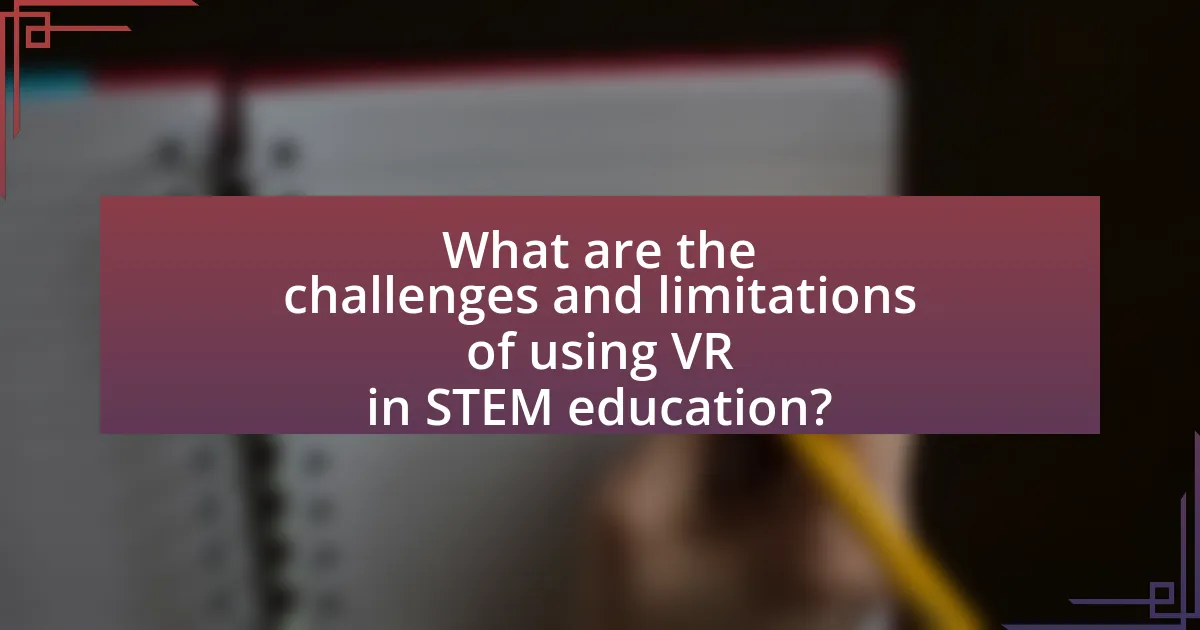
What are the challenges and limitations of using VR in STEM education?
The challenges and limitations of using VR in STEM education include high costs, technical issues, and limited accessibility. High costs associated with VR hardware and software can restrict adoption in educational institutions, as many schools may lack the budget for such technology. Technical issues, such as software bugs and hardware malfunctions, can disrupt learning experiences and hinder effective teaching. Additionally, limited accessibility arises from the need for specialized equipment and environments, which may not be available to all students, particularly in underfunded areas. These factors collectively impede the widespread implementation of VR in STEM education, as evidenced by a study from the International Society for Technology in Education, which highlights that only 20% of schools have integrated VR into their curricula due to these barriers.
What technical barriers exist for implementing VR in classrooms?
Technical barriers for implementing VR in classrooms include high costs, inadequate infrastructure, and limited access to compatible devices. The initial investment for VR hardware and software can be prohibitive for many educational institutions, with quality headsets costing several hundred dollars each. Additionally, many classrooms lack the necessary technological infrastructure, such as high-speed internet and sufficient power supply, to support VR applications effectively. Furthermore, the availability of devices that can run VR software is often limited, as not all students have access to personal VR equipment. These factors collectively hinder the widespread adoption of VR technology in educational settings.
How can schools overcome the cost of VR technology?
Schools can overcome the cost of VR technology by leveraging partnerships with technology companies and seeking grants specifically aimed at educational innovation. Collaborations with tech firms can provide access to discounted or donated VR equipment and software, as seen in initiatives like Google’s Expeditions program, which offers free resources to educators. Additionally, applying for grants from organizations such as the National Science Foundation can help secure funding for VR projects, as these grants often support STEM education enhancements. By utilizing these strategies, schools can effectively reduce the financial burden associated with implementing VR technology in their curricula.
What are the limitations of VR content in STEM education?
The limitations of VR content in STEM education include high costs, accessibility issues, and potential for cognitive overload. High costs associated with VR hardware and software can restrict access for many educational institutions, limiting the widespread adoption of VR in STEM curricula. Accessibility issues arise as not all students may have the necessary technology or physical capabilities to engage with VR content effectively. Additionally, cognitive overload can occur when students are overwhelmed by the immersive experience, which may hinder learning rather than enhance it. Studies have shown that while VR can improve engagement, it may also distract from core educational objectives if not designed thoughtfully.
How do educators perceive the effectiveness of VR in STEM learning?
Educators generally perceive the effectiveness of virtual reality (VR) in STEM learning as highly positive. They recognize that VR enhances student engagement, facilitates experiential learning, and allows for complex concepts to be visualized in an interactive manner. Research conducted by the University of Maryland found that students using VR in STEM subjects demonstrated a 30% increase in retention rates compared to traditional learning methods. Additionally, a study published in the Journal of Educational Technology & Society highlighted that 85% of educators reported improved understanding of scientific concepts when VR was integrated into their curriculum. These findings support the view that VR is a valuable tool for enhancing STEM education.
What feedback have teachers provided regarding VR tools?
Teachers have provided overwhelmingly positive feedback regarding VR tools, highlighting their effectiveness in enhancing student engagement and understanding of complex STEM concepts. Many educators report that VR tools facilitate immersive learning experiences, allowing students to visualize and interact with abstract ideas, which significantly improves retention and comprehension. For instance, a study published in the Journal of Educational Technology & Society found that 85% of teachers using VR in their classrooms observed increased student motivation and participation. Additionally, teachers noted that VR tools cater to diverse learning styles, making it easier to reach students who may struggle with traditional teaching methods.
How do students respond to VR-based learning experiences?
Students generally respond positively to VR-based learning experiences, often reporting increased engagement and motivation. Research indicates that immersive VR environments enhance understanding of complex STEM concepts by providing interactive and visual representations. For instance, a study by Mikropoulos and Natsis (2011) found that students using VR for learning physics demonstrated improved conceptual understanding compared to traditional methods. Additionally, a survey conducted by the University of Maryland revealed that 85% of students felt more focused and retained information better when learning through VR. These findings underscore the effectiveness of VR in enhancing student responses and learning outcomes in STEM education.
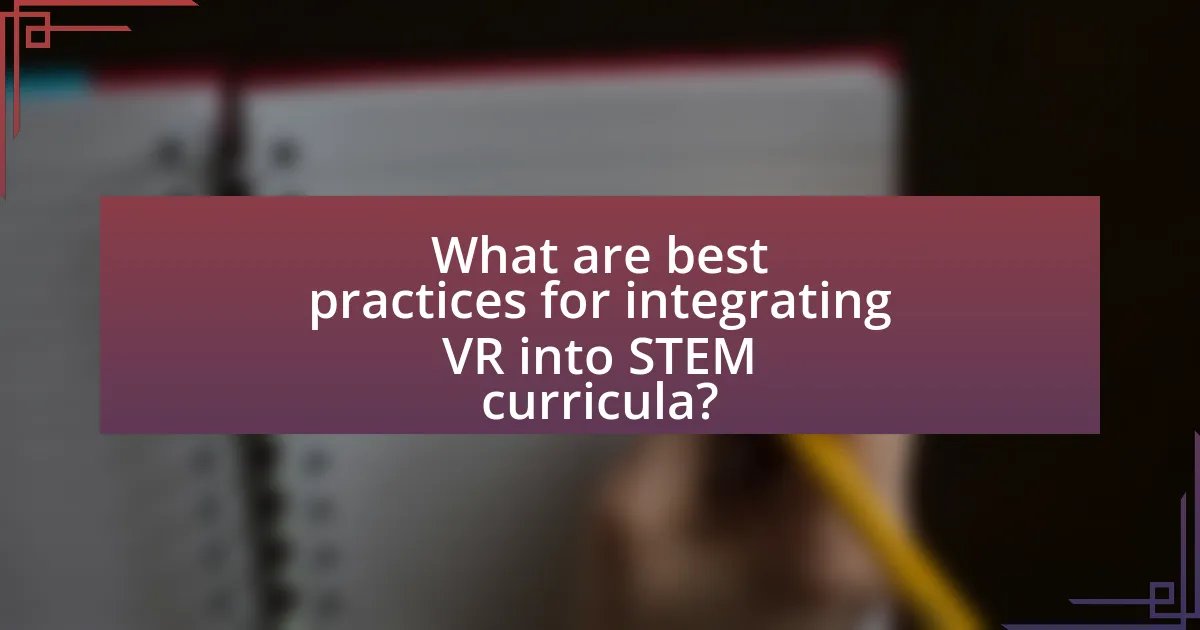
What are best practices for integrating VR into STEM curricula?
Best practices for integrating VR into STEM curricula include aligning VR experiences with learning objectives, ensuring accessibility for all students, and providing adequate training for educators. Aligning VR content with specific learning goals enhances engagement and retention, as evidenced by studies showing that immersive experiences can improve understanding of complex concepts. Ensuring accessibility allows all students, including those with disabilities, to benefit from VR technology, which is crucial for inclusive education. Additionally, training educators on how to effectively use VR tools is essential; research indicates that teacher proficiency in technology integration significantly impacts student outcomes.
How can educators effectively implement VR in their teaching strategies?
Educators can effectively implement VR in their teaching strategies by integrating immersive experiences that align with curriculum objectives. This involves selecting VR content that enhances understanding of complex STEM concepts, such as simulations for scientific experiments or virtual field trips to historical sites. Research indicates that students engaged in VR learning demonstrate improved retention and comprehension, as evidenced by a study published in the Journal of Educational Technology & Society, which found that 85% of students reported a deeper understanding of the subject matter when using VR tools. Additionally, educators should provide training for both teachers and students to maximize the potential of VR technology, ensuring that it complements traditional teaching methods rather than replacing them.
What training do teachers need to use VR effectively?
Teachers need training in VR technology, pedagogical strategies, and content integration to use VR effectively. This training should include hands-on experience with VR tools, understanding the educational applications of VR in STEM, and developing lesson plans that incorporate VR experiences. Research indicates that effective VR training enhances teachers’ confidence and competence in delivering immersive learning experiences, which can lead to improved student engagement and understanding in STEM subjects.
How can educators assess student learning through VR experiences?
Educators can assess student learning through VR experiences by utilizing immersive assessments that evaluate knowledge application in realistic scenarios. For instance, educators can design VR simulations that require students to solve complex problems or complete tasks relevant to STEM subjects, allowing for real-time observation of their decision-making processes and problem-solving skills. Research indicates that immersive environments enhance engagement and retention, with a study by Mikropoulos and Natsis (2011) showing that students in VR settings demonstrated improved understanding of scientific concepts compared to traditional methods. This evidence supports the effectiveness of VR as a tool for assessing student learning in STEM education.
What resources are available for educators interested in VR for STEM?
Educators interested in VR for STEM can access a variety of resources, including platforms like Google Expeditions, which offers immersive virtual field trips, and Labster, which provides virtual lab simulations for science education. Additionally, organizations such as the Virtual Reality Developers Conference (VRDC) and the International Society for Technology in Education (ISTE) offer workshops and professional development opportunities focused on integrating VR into STEM curricula. Research indicates that using VR in education can enhance engagement and understanding, as demonstrated in studies published in the Journal of Educational Technology & Society, which highlight improved learning outcomes in STEM subjects through immersive experiences.
What platforms offer VR content specifically for STEM education?
Platforms that offer VR content specifically for STEM education include Oculus Education, Google Expeditions, and Labster. Oculus Education provides immersive experiences that allow students to explore complex scientific concepts in a virtual environment. Google Expeditions enables educators to take students on virtual field trips to various locations, enhancing their understanding of STEM subjects. Labster offers virtual lab simulations that allow students to conduct experiments in a risk-free setting, reinforcing their practical skills and theoretical knowledge. These platforms are designed to enhance engagement and understanding in STEM learning through interactive and immersive experiences.
How can educators collaborate to share VR resources and experiences?
Educators can collaborate to share VR resources and experiences by forming professional learning communities and utilizing online platforms dedicated to educational technology. These communities enable educators to exchange VR lesson plans, share best practices, and provide feedback on VR applications. For instance, platforms like Google Classroom and Edmodo facilitate the sharing of VR content among educators, allowing them to access a wider range of resources and experiences. Research indicates that collaboration among educators enhances the integration of technology in classrooms, leading to improved student engagement and learning outcomes.
What are practical tips for maximizing the impact of VR in STEM learning?
To maximize the impact of VR in STEM learning, educators should integrate VR experiences that align with curriculum objectives, ensuring relevance to the subject matter. Research indicates that immersive VR environments can enhance engagement and retention; for instance, a study by Mikropoulos and Natsis (2011) found that students using VR for learning complex scientific concepts demonstrated improved understanding compared to traditional methods. Additionally, providing opportunities for collaborative VR experiences fosters teamwork and communication skills, which are essential in STEM fields. Implementing regular assessments to gauge student progress in VR settings can also help tailor experiences to individual learning needs, further enhancing educational outcomes.
